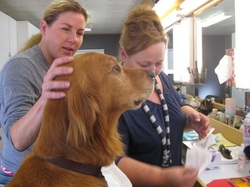
Although "tricks" are great, they are not often utilized in films. What most productions are looking for are natural behaviors that your animal would do if it was in your home with you. Such as a dog walking along side an actor, a cat sitting in a window sill and jumping off into an actor's lap. A rat or mouse
scampering over a counter top or running across a floor. These are the things that are wonderful to train your animal to do.
When you have trained a behavior on your pet,
be sure to transfer it to other people. It is easy to get your dog to run to you and lick your face, but can you give him a command to do that to a total stranger? Now step back 10 feet and give the command. Now step back farther and hide behind a camera with 6 or more people staring directly at your dog and
still give him the command to do that to a total stranger. This is an example of what will be expected.
STAY is one of the most important commands for animals in film. Sit stay, down stay, stand stay: these are separate behaviors which are extremely useful. Often they want a dog to sit or lie down in a stay, but yet tilt their heads, pick up their ears, bark and offer different facial expressions. So when training your stay, you still have to be able to get your pet's attention and make them react to you without releasing from their stay. Hand signals for your commands are very useful. Many times the animals have to perform while the actors have dialogue and you cannot make any noise.
After I have a command on my animals, I will take them outside their home environment and start perfecting the command in public places. Bus terminals at supper time, outside busy grocery store doors, public
parks with lots of distractions, outside of school yards at recess time. If you can still get your pet to listen, you're on your way.
scampering over a counter top or running across a floor. These are the things that are wonderful to train your animal to do.
When you have trained a behavior on your pet,
be sure to transfer it to other people. It is easy to get your dog to run to you and lick your face, but can you give him a command to do that to a total stranger? Now step back 10 feet and give the command. Now step back farther and hide behind a camera with 6 or more people staring directly at your dog and
still give him the command to do that to a total stranger. This is an example of what will be expected.
STAY is one of the most important commands for animals in film. Sit stay, down stay, stand stay: these are separate behaviors which are extremely useful. Often they want a dog to sit or lie down in a stay, but yet tilt their heads, pick up their ears, bark and offer different facial expressions. So when training your stay, you still have to be able to get your pet's attention and make them react to you without releasing from their stay. Hand signals for your commands are very useful. Many times the animals have to perform while the actors have dialogue and you cannot make any noise.
After I have a command on my animals, I will take them outside their home environment and start perfecting the command in public places. Bus terminals at supper time, outside busy grocery store doors, public
parks with lots of distractions, outside of school yards at recess time. If you can still get your pet to listen, you're on your way.
